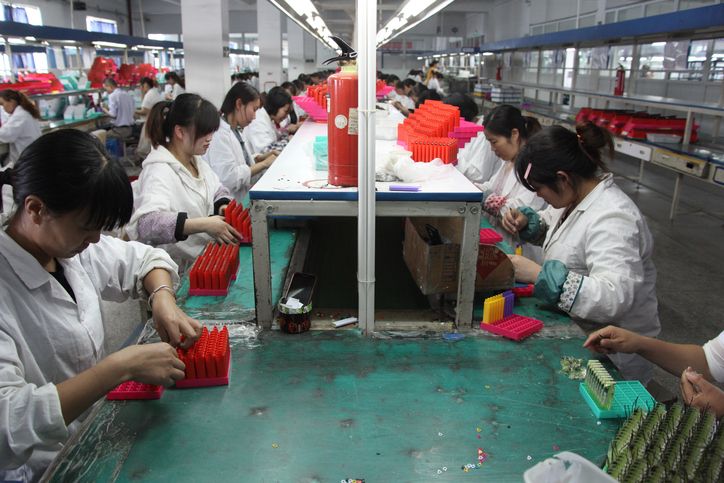 But can he really draw manufacturing jobs from China? Experts say most jobs can’t return to American factories because they’ve been taken over by automation and technology, not Chinese workers. While the manufacturing sector has been growing and is estimated to add 3.5 million jobs over the next decade, these jobs are quite different from the unskilled positions of the past.
But can he really draw manufacturing jobs from China? Experts say most jobs can’t return to American factories because they’ve been taken over by automation and technology, not Chinese workers. While the manufacturing sector has been growing and is estimated to add 3.5 million jobs over the next decade, these jobs are quite different from the unskilled positions of the past.
Most manufacturing jobs lost over the past couple of decades have been due to technology. A study by the Center for Business and Economic Research at Ball State University said that 85% of the 5.6 million job losses between 2000 and 2010 were attributed to automation rather than international trade. Because manufacturers have leveraged technology to do more with less, they’ve been able to increase output with fewer people. Robotics, efficiency improvements, data analytics, and new processes have eliminated millions of positions.
“Automation has transformed the American factory, rendering millions of low-skilled jobs redundant,” Mireya Solis, senior fellow at the Brookings Institution, told the Financial Times. “Fast-spreading technologies like robotics and 3D printing will exacerbate the trend.”
Nevertheless, a flood of Chinese imports have indirectly eliminated jobs by reducing demand for American products. A study published in The Journal of Labor Economics did find, however, that the U.S. lost at least 2 million jobs between 1999 and 2011 because of a surge in Chinese imports. But even if China blinked out of existence tomorrow, there just wouldn’t be a need for much of the work America lost. The low-skilled labor that fueled manufacturing a generation ago has little place on today’s manufacturing floors, which are largely driven by computers, robots and technology.
Meanwhile, China also has been grappling with its own jobs losses. Many Chinese workers are losing their jobs because of rising costs, a slower domestic economy, and stiff competition from a number of other countries, including the U.S. The labor market in China has changed in recent years and wages for Chinese workers have risen nearly 30% over the past three years. Many companies are moving from China to places like Vietnam and Bangladesh where labor costs are half as much.
And even though it’s a drop in the bucket of the jobs lost over the years, some are already returning here on their own. A 2015 study by Boston Consulting Group said that the costs of manufacturing in China’s major export zones were almost the same as those in the U.S., when factoring in wages, productivity, costs and other factors. The nonprofit advocacy group Reshoring Initiative also noted that, in 2015, the country added almost as many jobs due to foreign investment as it lost to offshoring. Walmart, Ford and Boeing alone have reshored more than 11,000 jobs in the past year.

Chief Executive Group exists to improve the performance of U.S. CEOs, senior executives and public-company directors, helping you grow your companies, build your communities and strengthen society. Learn more at chiefexecutivegroup.com.
0

1:00 - 5:00 pm
Over 70% of Executives Surveyed Agree: Many Strategic Planning Efforts Lack Systematic Approach Tips for Enhancing Your Strategic Planning Process
Executives expressed frustration with their current strategic planning process. Issues include:
Steve Rutan and Denise Harrison have put together an afternoon workshop that will provide the tools you need to address these concerns. They have worked with hundreds of executives to develop a systematic approach that will enable your team to make better decisions during strategic planning. Steve and Denise will walk you through exercises for prioritizing your lists and steps that will reset and reinvigorate your process. This will be a hands-on workshop that will enable you to think about your business as you use the tools that are being presented. If you are ready for a Strategic Planning tune-up, select this workshop in your registration form. The additional fee of $695 will be added to your total.

2:00 - 5:00 pm
Female leaders face the same issues all leaders do, but they often face additional challenges too. In this peer session, we will facilitate a discussion of best practices and how to overcome common barriers to help women leaders be more effective within and outside their organizations.
Limited space available.

10:30 - 5:00 pm
General’s Retreat at Hermitage Golf Course
Sponsored by UBS
General’s Retreat, built in 1986 with architect Gary Roger Baird, has been voted the “Best Golf Course in Nashville” and is a “must play” when visiting the Nashville, Tennessee area. With the beautiful setting along the Cumberland River, golfers of all capabilities will thoroughly enjoy the golf, scenery and hospitality.
The golf outing fee includes transportation to and from the hotel, greens/cart fees, use of practice facilities, and boxed lunch. The bus will leave the hotel at 10:30 am for a noon shotgun start and return to the hotel after the cocktail reception following the completion of the round.